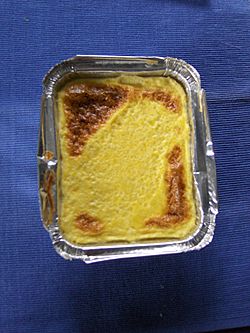Kalvdans facts for kids
 |
|
| Type | Dessert |
|---|---|
| Place of origin | Scandinavia |
| Main ingredients | Colostrum milk, water |
Kalvdans is a special dessert from Scandinavia. Its name means "calf dance." This name refers to its jiggly, pudding-like texture. It's a traditional treat made from a unique ingredient. This ingredient is colostrum milk. Colostrum is the very first milk a cow produces. It comes right after she gives birth to a calf.
Contents
History of Kalvdans
Kalvdans has been a part of Swedish cooking for a very long time. People have enjoyed this dessert for centuries. It was even mentioned in an old book from 1682. This book was called Project af swensk grammatica.
The old book also called it 'kalvost'. This means "calf-cheese." Swedish people who moved to North America also took this tradition with them. However, it is not eaten as often today. This is because fewer families keep their own cows.
How Kalvdans is Made
Making kalvdans is quite interesting. First, the colostrum milk is mixed with water. Then, this mixture is carefully heated. Colostrum milk has a lot of protein. Because of this, it gets firm when it's heated. It's a bit like how eggs get firm when you cook them.
This process makes the dessert thicken. It turns into a soft, pudding-like treat. The unique texture is what gives kalvdans its name.
Why Kalvdans is Rare Today
Today, kalvdans is not made very often in Swedish homes. This is due to health rules in Sweden. Unpasteurized milk can only be sold directly from farms. This means it's harder to get the special colostrum milk.
Because of these rules, it's difficult to make kalvdans often. In 2008, kalvdans was recognized as a special food. It was added to the 'Ark of Taste'. This is a list by the Slow Food movement. It helps protect unique and traditional foods.
Similar Desserts Around the World
Kalvdans is not the only dessert made from colostrum milk. Other countries have similar traditions.
- In Iceland, there is a pudding called ábrystir. It is also made from colostrum milk.
- Finland has a similar dish called uunijuusto. This name means "oven cheese."
- In England, colostrum milk was called "beestings." People traditionally used it to make puddings.
- In India, there is a dessert called kharvas. This treat is made from buffalo colostrum milk.
- Sometimes, in Norwegian and Danish languages, "kalvedans" can also mean a type of jelly. But this jelly is made from veal meat, not milk.
See also
 In Spanish: Kalvdans para niños
In Spanish: Kalvdans para niños

